720 SPRINGERS- Small setter or leggy cocker
SPRINGERS–SMALL SETTERS OR LEGGY COCKERS?
by David Hancock
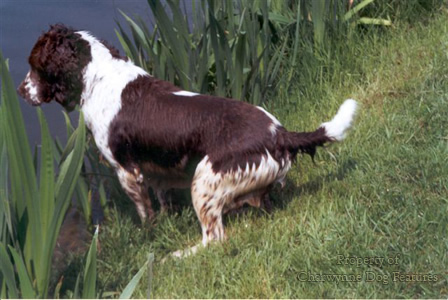 If you look at English Springers in the shooting field and then at those on the show bench, you could be forgiven for asking if the breed isn’t becoming ‘any variety sporting spaniel’. I see working dogs the size and shape of Cocker Spaniels, lacking essential Springer type; I come across show Springers that resemble reduced setters, especially now that undocked tails are common. In the more distant past such a blurring was understandable, before the days of pure-breeding and with the nature of the shooting country deciding on the leg length required in the dogs being shot over. In the end type in the working dogs will be decided on their performance alone but what happens to the breed in this case?
If you look at English Springers in the shooting field and then at those on the show bench, you could be forgiven for asking if the breed isn’t becoming ‘any variety sporting spaniel’. I see working dogs the size and shape of Cocker Spaniels, lacking essential Springer type; I come across show Springers that resemble reduced setters, especially now that undocked tails are common. In the more distant past such a blurring was understandable, before the days of pure-breeding and with the nature of the shooting country deciding on the leg length required in the dogs being shot over. In the end type in the working dogs will be decided on their performance alone but what happens to the breed in this case?
Nearly two hundred years ago, Richard Lawrence, a veterinary surgeon of great experience with dogs, was writing in "The Complete Farrier" that: "The true English springer differs but little in figure from the setter, except in size; varying only in a small degree, if any, from a red yellow or liver colour, which seems to be the invariable external standard of this breed." So our knowledgeable more distant ancestors considered the breed to be setter-like; contemporary experts have ruled out all mention of this in the extant blueprint for the breed.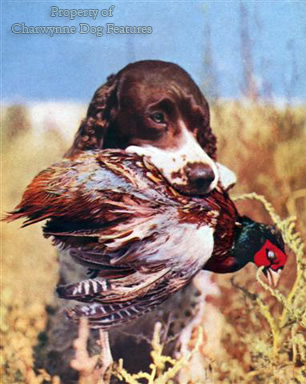
Few would dispute the supremacy of the English Springer Spaniel at spaniel work in the last one hundred years. With the Labrador Retriever, the Springer has dominated field trials since the First World War; these two breeds having on sheer field merit, ruled the roost in the working gundog world. The astounding rise in popularity here of the hunt, point and retrieve breeds from mainland Europe in the last sixty years may in time change the whole emphasis of dog-work in the shooting field, but, of our native breeds, the fondness of sportsmen for these two gundog breeds continues without check.
If asked to describe their breed, most working Springer owners would respond on the lines of "liver and white spaniel, foot and a half high and a real goer!" The Kennel Club would opt for their descriptive if not particularly accurate 400-odd word breed standard. But for the latter to state that this breed is "of ancient and pure origin, oldest of sporting gundogs" with a gait or movement "strictly his own" withstands no serious scrutiny. And phrases in this authorised breed standard like: "skull of medium length", "eyes medium", "nicely feathered ears", "jaws strong", "body neither too long nor too short", "hind legs well let down" and "ears lobular, good length and width" offer precious little help with their vagueness.
What is abundantly clear however to any admirer of the breed who studies dogs and prizes breed characteristics is that the English Springer has simply lost its essential type. Broadly speaking the show type looks like a reduced setter whilst the working dog resembles a liver and white Cocker. The showmen rate appearance first; the gundog men must have function first. But every member of a breed must display type.
Blaine, writing in 1807, stated that: "The variety of Spaniels are numerous. A popular distinction made between them by many writers is into Springers, Cockers, and Water Spaniels. Conventionally this distinction is understood, but critically it will not bear examination, particularly as regards the first two divisions." This is supported by the fact that the Welsh Springer has been called the Welsh Cocker for much of its history. Another authority of that time wrote that: "The true English Spaniel differs but little in figure from the Setter except in size." The acknowledged spaniel authority CA Phillips wrote a century ago that: "...strictly speaking, all the different varieties of Spaniels are 'Springers', the name originally having been used in contradistinction to 'Setters'..." But once you prize a gundog breed as just that, breed type matters.
The Sportsman’s Cabinet of 1803 recorded: “It creates no surprize with the observant traveller to hear in Ireland, the pointer almost invariably called an English spaniel, as this, with a sportsman of that country might be considered only a slight deviation from the custom of this; but in the northern counties of England, where the shooting is so good, and the breed of dogs so excellent, it is not without considerable astonishment we hear pointers distinguished by the name of smooth spaniels, and setters by the denomination of rough spaniels. The real springing spaniel is with them termed a cocker, as the woodcock is there the only bird for which they are brought into use, consequently, but rarely to be seen in those districts; as, for instance, in some of the northern country-towns, where from thirty to forty brace of setters and pointers are kept in good state and proper condition, not one brace of well-bred and well-broke springing spaniels are to be found.” Breed researchers seeking past mentions of their favoured breed beware!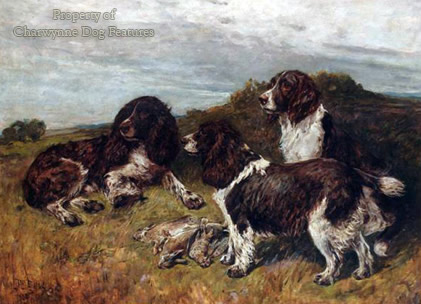
The Kennel Club-authorised breed standard states that the English Springer is the "highest on leg and raciest in build of all British Land Spaniels", going on to claim that this breed is "of ancient and pure origin". Gervaise Markham however was writing in the 17th century: "It is reasonable that people should cross Land Spaniels and Water Spaniels, and the Mungrells between these, and the Mungrells of either with the Shallow Flew'd Hound, the Tumbler, the Lurcher and the small bastard Mastiff...all of which are yet inferior to the truebred Land Spaniel - if one could still find one of those". Not much support for the "pure origin" claimants of the KC here!
The Springers that I see working in the field are anything but high on the leg and racy in build as the KC also insists they must be. One day a pedantic dissatisfied purchaser of a Springer pup might invoke the Trades Descriptions Act! Will Sprockers one day outnumber Springers!
Colour is not much of a guide either in identifying a real English Springer. The KC nowadays decrees that their colour should be: Liver and white, black and white, or either of these colours with tan markings. Around 1807, Captain Brown, regarded as "a very creditable authority" described them as red, yellow or liver colour and white. Eighty years ago the breed standard itself specified: black and tan; liver and tan; black, liver, black, tan and white; liver and white; liver, tan and white; lemon and white, roans etc. Whatever happened to the lemon and whites? Are they Springers no longer? This edition of the standard incidentally put the weight of the dog at about 40lbs. Forty years later it was 50lbs. On the question of colour, the standard of thirty years ago stated that: "...any recognised Land Spaniel colour is acceptable"; did this mean that whole-coloured jet-black was acceptable? For this is a land spaniel colour.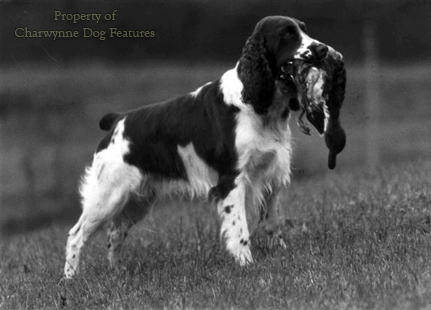
Writing in 1906, Rawdon Lee stated that the breed could be of "any hue, barring orange and white, which is now the acknowledged colour of the Welsh Springer or cocker". One hundred years before this, they could be 'red' - the Welsh Springer colour. So in this breed, prized for its ancient origin, the ancient colours are no longer desired! The American KC insists that "off" colours such as lemon, red or orange should be penalised and their possessors not placed. Yet they also insist that those dogs in the breed lacking true English springer type should be penalised. The true type in their country of origin contained red and yellow in 1807 and lemon in 1907. The real purpose behind the American wording is given away in the preamble to the AKC breed standard: "Unquestionably the present standard has helped to make the Springer more uniform as a breed." In other words uniformity is seen as having more merit than traditional variety. This is breeding to suit the breeders not the dog. The result of such thinking in this country has been to remove the rich variety in coat colours in the breed, i.e. its ancient heritage. Yet today we have a breed which is anything but uniform. This may not matter in the shooting field but does affect breed type.
The "pure origin" of the breed, claimed by the Kennel Club but disputed by countless authoritative writers, has not been improved in the last hundred years by the introduction of Pointer, Irish Setter and black and tan Field Spaniel blood, as the much respected Frank Warner Hill has testified. I am never against the introduction of outside blood to revitalise any purebred strain and I don't believe that small size variations or colour matter at all. But genuine breed type does matter, it can be a sign that the real blood is present. If breed type does not matter and field performance is all, how can breeds survive?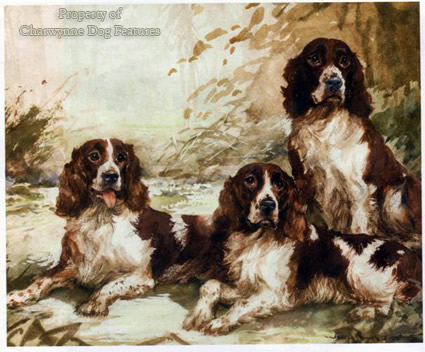
I don't mind a Springer that is 16" or 22" at the withers. I can see no reason to object to a lemon and white, orange and white or even a mahogany red and white Springer, if it can work. But a lack of true type is much more worrying. The renowned O'Vara Springers, like FT champions Spy, Spurt, Spark and Sarkie were considerably smaller than say the Sandylands' Springers bred by the late Gwen Broadley. But all of them had the essential type so necessary if this breed is to retain its identity beyond coat colour. I don't believe this 'typiness' comes from any idiosyncrasy of gait, as the breed standard hints, although their manner of hunting can be most distinctive.
For me, the essential type in Springers is revealed in: the overall appearance of a small setter, the shape of the head, the eager look in the eye and the ratio of body length to body height. The correct English Springer body has the same measurement from the withers to the ground as from the withers to the root of the tail. This ratio produces a thoroughly functional dog, develops the best drive and allows a balanced symmetrical physique. If this ratio is respected, cloddy short-legged dogs or bassetised long-backed ones are ruled out. The eager look in the eye I would rate highly; it is the desire to work, keenness to hunt, willingness to give service, backed by good construction and sound movement which makes any working dog. In 1790 this type of spaniel was described rather neatly with these words: "...is lively, active and pleasant; an unwearied pursuer of its game; and very expert in raising woodcocks and snipes from their haunts in woods and marshes, through which it ranges with amazing perseverance". Perhaps these are the only words a sensible breed standard really needs, for they tell us what an English Springer is designed to be – a totally-committed working gundog.